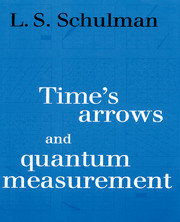Book contents
- Frontmatter
- Contents
- Preface
- 1 Introduction
- 2 Irreversibility
- 3 Arrows of time
- 4 Correlating arrows of time
- 5 Two-time boundary value problems
- 6 Quantum measurements: cats, clouds and everything else
- 7 Existence of special states
- 8 Selection of special states
- 9 Abundance of special states
- 10 Experimental tests
- 11 Conclusions and outlook
- Author index
- Index
4 - Correlating arrows of time
Published online by Cambridge University Press: 05 August 2012
- Frontmatter
- Contents
- Preface
- 1 Introduction
- 2 Irreversibility
- 3 Arrows of time
- 4 Correlating arrows of time
- 5 Two-time boundary value problems
- 6 Quantum measurements: cats, clouds and everything else
- 7 Existence of special states
- 8 Selection of special states
- 9 Abundance of special states
- 10 Experimental tests
- 11 Conclusions and outlook
- Author index
- Index
Summary
In the last chapter we enumerated ‘arrows of time.’ There was a subtheme concerned with which candidates made it to the list, which didn't, trying to eliminate arrows that were immediate consequences of others. Now the subtheme becomes the theme.
We are concerned with correlating arrows of time. Our most important conclusion will be that the thermodynamic arrow of time is a consequence of the expansion of the universe. Coffee cools because the quasar 3C273 grows more distant. We will discuss other arrows, in particular the radiative and the biological, but for them the discussion is a matter of proving (or perhaps formulating) what you already believe. For the thermo/cosmo connection there remains significant controversy.
As far as I know it was Thomas Gold who proposed that the thermodynamic arrow of time had its origins in cosmology, in particular in the expansion of the universe. Certainly there had been a lot of discussion of arrows of time before his proposal, but in much of this discussion you could easily get lost, not knowing whether someone was making a definition or solving a problem. Now I'm sure the following statement slights many deep thinkers, but I would say that prior to Gold's idea the best candidate for an explanation of the thermodynamic arrow was that there had been an enormous fluctuation. If you have a big enough volume and if you wait long enough, you would get a fluctuation big enough for life on earth.
- Type
- Chapter
- Information
- Time's Arrows and Quantum Measurement , pp. 123 - 160Publisher: Cambridge University PressPrint publication year: 1997



